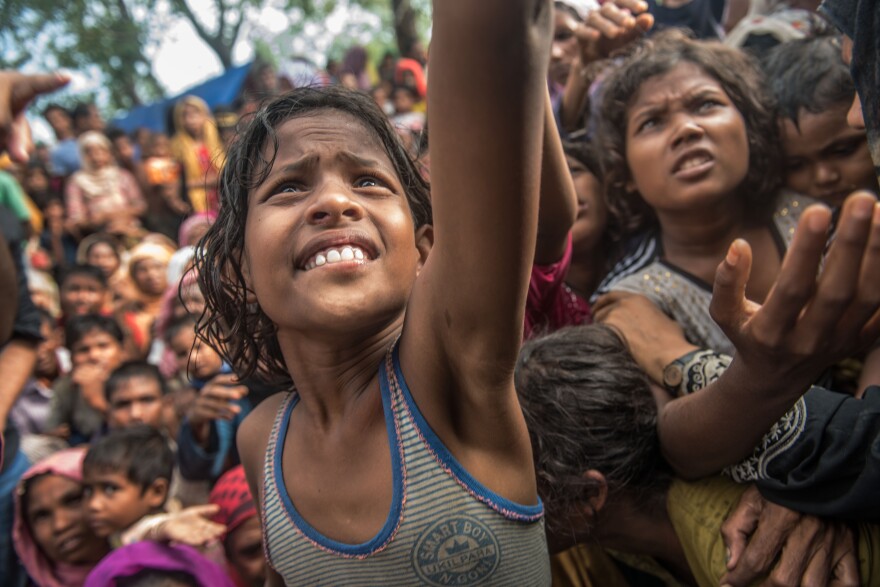Nearly 400,000 Rohingya people have fled government violence in Myanmar and crossed into neighboring Bangladesh. The majority of them are children — 60 percent, by U.N. estimates. And at least 1,100 are separated from their parents.
The challenges for aid groups are unfathomable with a refugee crisis this large, caused by what Zeid Ra'ad Al Hussein, the United Nations high commissioner for human rights, says seems to be "a textbook example of ethnic cleansing."
The situation is even more daunting when so many children are at risk.
Kids are vulnerable to physical illnesses like waterborne diseases and skin infections — and mental health problems spurred by trauma. They've been shot at and they've trekked across areas with land mines.
Hearing some of their stories has shocked Christophe Boulierac, the UNICEF spokesman in Geneva who's currently posted to Bangladesh.
He remembers a teenage boy he met earlier this week who had fled Myanmar.
"He told me he saw his mother and sister shot dead in front of him, and then he fled," Boulierac says. "I asked him, what do you feel, how do you feel? And he told me, 'I am not feeling anything. I just want to eat, some shelter and then maybe I will start thinking.'"

Aid groups are working to meet such basic needs as food and shelter.
Most of the new arrivals head to Kutupalong, the largest of Bangladesh's refugee camps, and makeshift settlements next to it. Kutupalong has been there for years, has some infrastructure and is near the Myanmar border.
But it's been tough for the newly arrived refugees to find a place to camp out. Many people have used materials like bamboo and plastic to make their own improvised shelters.

"Most of them are just homemade tents that are made from a few skinny bamboo poles that have been either found or purchased, stuck into the ground, that have been tied together with a piece of plastic sheeting thrown on top and another one on the ground if they've got it," says Pavlo Kolovos, the Bangladesh head of mission for Doctors Without Borders. "Space is a premium."
Even in this dire setting, the humanitarian agencies are seeking to give kids time and space to play — and to add structure to their lives, which can help them recover from the traumatic experiences they might have experienced.
"They need to feel safe," says Jean Lieby, chief of child protection for UNICEF Bangladesh. "Some have been six days walking through the rainforest."

"Child friendly spaces" in camp buildings, often with art supplies, offer a secure place to play and also help staffers identify youngsters who could need extra support such as counseling, Lieby says.
There are different signs to look for, he says: "Some are mute, not talking anymore. Sometimes children are shy just because they are shy. Some that were not shy before and that become extremely shy, we have to look into."

Not all kids who are refugees need counseling, Lieby says. But for some who have been severely affected by trauma, the psychological healing process can take decades.
"Some people that have been affected during the Rwanda genocide [in 1994] are still receiving trauma counseling," Lieby says.
Asked about providing therapy, Boulierac says: "We are really scaling up. Nobody has expected this influx."

Makeshift shelters have been popping up along the main road, which is clogged with trucks and other vehicles — putting refugee children at risk of getting hurt, says Kolovos of Doctors Without Borders.
The weather isn't helping, either. The dirt roads and paths within the camp have been muddied by rain – it's monsoon season there.
"Everybody kind of looks like they're wearing tan socks up to their shins, because it's just all ...it's a mess," he says.
What's it like to be an aid worker in this type of crisis situation? "You work 20 hours a day," he says, "and keep going."
Courtney Columbus is a multimedia journalist based in the Washington, D.C. area. She covers science, global health and consumer health. Her past work has appeared in the Arizona Republic and on Arizona PBS. Contact her @cmcolumbus11.
Copyright 2023 NPR. To see more, visit https://www.npr.org.




